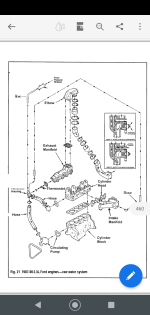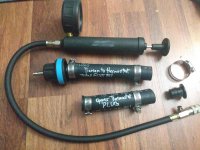andrewdouv
New member
Friend is looking to buy his first boat and I am helping him make a decision as I've had some experience.
Here's the deal on the boat we're looking at. Show up to test the motor on muffs on the driveway, hasn't been run since winterized. Previous owner gets the thing started after a few minutes of playing with the choke and throttle plate while cranking. Then he proceeds to rev the engine in neutral to keep it going (to me this is very bad for the engine to rev right after startup, not enough lubrication at that point). Anyway, the thing runs lousy at first backfiring and the works, I'm watching the gauges and oil pressure is at max on the gauge which I think was 60-70 psi. Temperature was normal. We notice water filling the bilge so we shut it down and investigate. I notice one of the core plugs is missing.
So I find the plug in the bilge, gently hammer it back on to the block. PO admits to half-assing winterizing the engine. He fires it back up and revs it again, and oil pressure is still reading high, temp normal, this time the engine is running smoothly. I inspect the core plug and no leaks at the seal. After two minutes of running oil pressure drops down to the middle of the gauge which if I remember is 40 psi. PO let's engine run come down to idle and we listen to it run excellent for the 15 minutes. We let it sit while we talked, restarted it a few times and to my ear and eyes everything was sounding and looking great at this point but obviously I am suspicious right now about about this engine and specifically damage that might have happened to the block.
Couple questions.
How could a missing core plug cause backfiring and lousy performance? Seems unrelated.
High oil pressure on startup.. could this just be cuz the oil was cold and thick and needed warmed up? My fear is that the block cracked internally and water is mixing with oil causing high pressure but why then would the pressure return to normal after a minute or two?
PO is letting us test drive it on a lake on Friday. I want to check for milky oil when I run it and inspect the block for leaks. Can I tell if oil is milky by opening dipstick and looking in with a flashlight or by just inspecting the dipstick when I pull it out or do I need to change the oil when I pull her out the water to see if milky. PO is a friend of my friend and is letting us do whatever tinkering we need to do.
Here's the deal on the boat we're looking at. Show up to test the motor on muffs on the driveway, hasn't been run since winterized. Previous owner gets the thing started after a few minutes of playing with the choke and throttle plate while cranking. Then he proceeds to rev the engine in neutral to keep it going (to me this is very bad for the engine to rev right after startup, not enough lubrication at that point). Anyway, the thing runs lousy at first backfiring and the works, I'm watching the gauges and oil pressure is at max on the gauge which I think was 60-70 psi. Temperature was normal. We notice water filling the bilge so we shut it down and investigate. I notice one of the core plugs is missing.
So I find the plug in the bilge, gently hammer it back on to the block. PO admits to half-assing winterizing the engine. He fires it back up and revs it again, and oil pressure is still reading high, temp normal, this time the engine is running smoothly. I inspect the core plug and no leaks at the seal. After two minutes of running oil pressure drops down to the middle of the gauge which if I remember is 40 psi. PO let's engine run come down to idle and we listen to it run excellent for the 15 minutes. We let it sit while we talked, restarted it a few times and to my ear and eyes everything was sounding and looking great at this point but obviously I am suspicious right now about about this engine and specifically damage that might have happened to the block.
Couple questions.
How could a missing core plug cause backfiring and lousy performance? Seems unrelated.
High oil pressure on startup.. could this just be cuz the oil was cold and thick and needed warmed up? My fear is that the block cracked internally and water is mixing with oil causing high pressure but why then would the pressure return to normal after a minute or two?
PO is letting us test drive it on a lake on Friday. I want to check for milky oil when I run it and inspect the block for leaks. Can I tell if oil is milky by opening dipstick and looking in with a flashlight or by just inspecting the dipstick when I pull it out or do I need to change the oil when I pull her out the water to see if milky. PO is a friend of my friend and is letting us do whatever tinkering we need to do.



